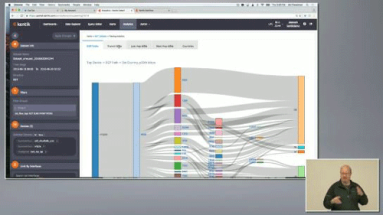Kentik Blog
























In our second post related to BrightTalk videos recorded with Kentik at Cisco Live 2016, Kentik CEO Avi Freedman talks about the increasing threats that digital businesses face from DDoS and other forms of attacks and service interruptions. Avi also discusses the attributes that are required or desirable in a network visibility solution in order to effectively protect a network.
Cisco Live 2016 gave us a chance to meet with BrightTalk for some video-recorded discussions on hot topics in network operations. This post focuses on the first of those videos, in which Kentik’s Jim Frey, VP Strategic Alliances, talks about the complexity of today’s networks and how Big Data NetFlow analysis helps operators achieve timely insight into their traffic.
It was a blast taking part in our first ever Networking Field Day (NFD12), presenting our advanced and powerful network traffic analysis solution. Being at NFD12 gave us the opportunity to get valuable response and feedback from a set of knowledgeable network nerd and blogger delegates. See what they had to say about Kentik Detect…
The recorded music market used to be dependent on physical objects to distribute recordings to buyers. Now it’s as if our headphone cords stretch all the way from our smartphones to the datacenter. That makes network performance and availability mission-critical for music services — and anyone else who serve ads, processes transactions, or delivers content. Which explains why some of the world’s top music services use Kentik Detect for network traffic analysis.
BGP used to be primarily of interest only to ISPs and hosting providers, but it’s become something with which all network engineers should get familiar. In this conclusion to our four-part BGP tutorial series, we fill in a few more pieces of the puzzle, including when — and when not — it makes sense to advertise your routes to a service provider using BGP.
Kentik CEO Avi Freedman joins Ethan Banks and Chris Wahl of the PacketPushers Datanauts podcast to discuss hot topics in networking today. The conversation covers the trend toward in-house infrastructure among enterprises that generate revenue from their IP traffic, the pluses and minuses of OpenStack deployments for digital enterprises, and the impact of DevOps practices on network operations.
In this post we continue our look at BGP — the protocol used to route traffic across the interconnected Autonomous Systems (AS) that make up the Internet — by clarifying the difference between eBGP and iBGP and then starting to dig into the basics of actual BGP configuration. We’ll see how to establish peering connections with neighbors and to return a list of current sessions with useful information about each.
BGP is the protocol used to route traffic across the interconnected Autonomous Systems (AS) that make up the Internet, making effective BGP configuration an important part of controlling your network’s destiny. In this post we build on the basics covered in Part 1, covering additional concepts, looking at when the use of BGP is called for, and digging deeper into how BGP can help — or, if misconfigured, hinder — the efficient delivery of traffic to its destination.
In most digital businesses, network traffic data is everywhere, but legacy limitations on collection, storage, and analysis mean that the value of that data goes largely untapped. Kentik solves that problem with post-Hadoop Big Data analytics, giving network and operations teams the insights they need to boost performance and implement innovation. In this post we look at how the right tools for digging enable organizations to uncover the value that’s lying just beneath the surface.








